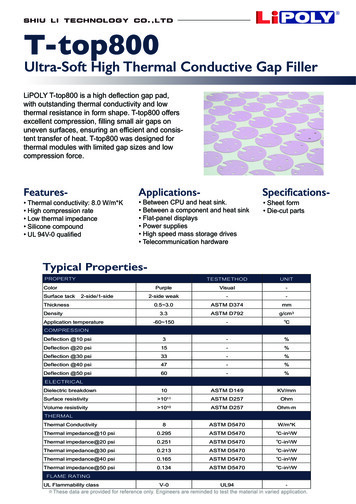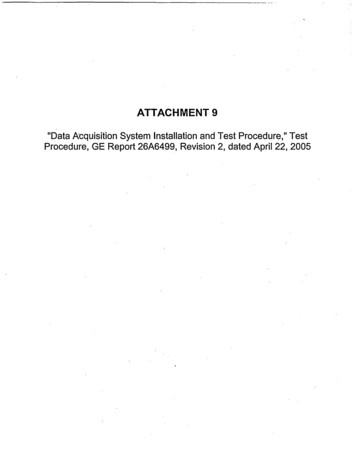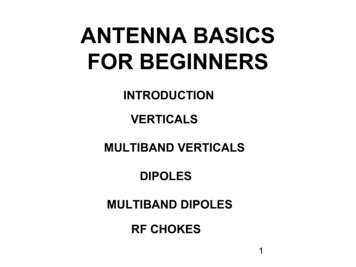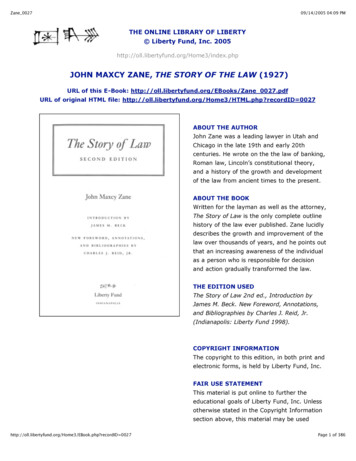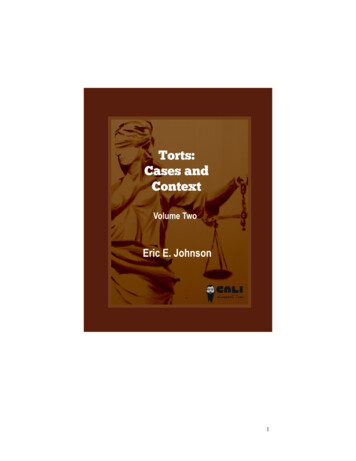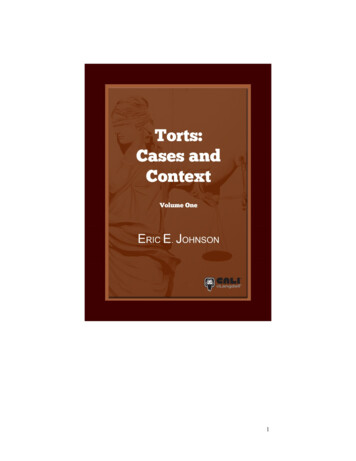
Transcription
Chapter3Ohm’s LawTopics Covered in Chapter 33-1: The Current I V/R3-2: The Voltage V IR3-3: The Resistance R V/I3-4: Practical Units3-5: Multiple and Submultiple Units 2007 The McGraw-Hill Companies, Inc. All rights reserved.
Topics Covered in Chapter 3 3-6: The Linear Proportion between V and I3-7: Electric Power3-8: Power Dissipation in Resistance3-9: Power Formulas3-10: Choosing a Resistor for a Circuit3-11: Electric Shock3-12: Open-Circuit and Short-Circuit TroublesMcGraw-Hill 2007 The McGraw-Hill Companies, Inc. All rights reserved.
Ohm’s Law Ohm's law states that, in anelectrical circuit, the currentpassing through mostmaterials is directlyproportional to the potentialdifference applied acrossthem.
3-1—3-3: Ohm’s Law Formulas There are three forms ofOhm’s Law: I V/R V IR R V/I where: I Current V Voltage R ResistanceFig. 3-4: A circle diagram to help in memorizing the Ohm’s Law formulas V IR, I V/R,and R V/I. The V is always at the top.Copyright The McGraw-Hill Companies, Inc. Permission required for reproduction or display.
3-1: The Current I V/R I V/R In practical units, this lawmay be stated as: amperes volts / ohmsFig. 3-1: Increasing the applied voltage V produces more current I to light the bulb withmore intensity.Copyright The McGraw-Hill Companies, Inc. Permission required for reproduction or display.
3-4: Practical Units The three forms of Ohm’s law can be used to define thepractical units of current, voltage, and resistance: 1 ampere 1 volt / 1 ohm 1 volt 1 ampere 1 ohm 1 ohm 1 volt / 1 ampere
3-4: Practical UnitsApplying Ohm’s Law?20 V4ΩVI R20 V 5AI 4Ω1A?12 Ω V 1A 12 Ω 12 V3A6V?6V 2ΩR 3A
Problem Solve for the resistance, R, when V and I are knowna.b.c.d.V 14 V, I 2 A, R ?V 25 V, I 5 A, R ?V 6 V, I 1.5 A, R ?V 24 V, I 4 A, R ?
3-5: Multiple and Submultiple Units Units of Voltage The basic unit of voltage is the volt (V). Multiple units of voltage are: kilovolt (kV)1 thousand volts or 103 V megavolt (MV)1 million volts or 106 V Submultiple units of voltage are: millivolt (mV)1-thousandth of a volt or 10-3 V microvolt (µV)1-millionth of a volt or 10-6 V
3-5: Multiple and Submultiple Units Units of Current The basic unit of current is the ampere (A). Submultiple units of current are: milliampere (mA)1-thousandth of an ampere or 10-3 A microampere (µA)1-millionth of an ampere or 10-6 A
3-5: Multiple and Submultiple Units Units of Resistance The basic unit of resistance is the Ohm (Ω). Multiple units of resistance are: kilohm (kΩ)1 thousand ohms or 103 Ω Megohm (MΩ)1 million ohms or 106 Ω
Problem How much is the current, I, in a 470-kΩ resistor if itsvoltage is 23.5 V? How much voltage will be dropped across a 40 kΩresistance whose current is 250 µA?
3-6: The Linear Proportion betweenV and I The Ohm’s Law formula I V/R states that V and I aredirectly proportional for any one value of R.Fig. 3.5: Experiment to show that I increases in direct proportion to V with the same R. (a)Circuit with variable V but constant R. (b) Table of increasing I for higher V. (c) Graph of Vand I values. This is a linear volt-ampere characteristic. It shows a direct proportionbetween V and I.Copyright The McGraw-Hill Companies, Inc. Permission required for reproduction or display.
3-6: The Linear Proportion betweenV and I When V is constant: I decreases as R increases. I increases as R decreases. Examples: If R doubles, I is reduced by half. If R is reduced to ¼, I increases by 4. This is known as an inverse relationship.
3-6: The Linear Proportion betweenV and I Linear Resistance A linear resistance has a constant value of ohms. Its Rdoes not change with the applied voltage, so V and Iare directly proportional. Carbon-film and metal-film resistors are examples oflinear resistors.
3-6: The Linear Proportion betweenV and I1Ω2Ω 0 to 9 Volts2ΩAmperes4324Ω10 1 2 3 4 5 6 7 8 9VoltsThe smaller the resistor, the steeper the slope.
3-6: The Linear Proportion betweenV and IAmperes Nonlinear Resistance In a nonlinear resistance, increasing the applied Vproduces more current, but I does not increase in thesame proportion as the increase in V. Example of a Nonlinear Volt–Ampere Relationship: As the tungsten filament in a light bulb gets hot, itsresistance increases.Volts
3-6: The Linear Proportion betweenV and IThermistorCopyright The McGraw-Hill Companies, Inc. Permission required for reproduction or display.Amperes Another nonlinear resistance is a thermistor. A thermistor is a resistor whose resistance valuechanges with its operating temperature. As an NTC (negative temperature coefficient)thermistor gets hot, its resistance decreases.Volts
3-7: Electric Power The basic unit of power is the watt (W). Multiple units of power are: kilowatt (kW):1000 watts or 103 W megawatt (MW):1 million watts or 106 W Submultiple units of power are: milliwatt (mW):1-thousandth of a watt or 10-3 W microwatt (µW):1-millionth of a watt or 10-6 W
3-7: Electric Power Work and energy are basically the same, with identicalunits. Power is different. It is the time rate of doing work. Power work / time. Work power time.
3-7: Electric Power Practical Units of Power and Work: The rate at which work is done (power) equals theproduct of voltage and current. This is derived asfollows: First, recall that:1 volt 1 joule1 coulomband 1 ampere 1 coulomb1 second
3-7: Electric PowerPower Volts Amps, orP V I1 joule1 joule1 coulomb Power (1 watt) 1 second1 second1 coulomb
3-7: Electric Power Kilowatt Hours The kilowatt hour (kWh) is a unit commonly used forlarge amounts of electrical work or energy. For example, electric bills are calculated in kilowatthours. The kilowatt hour is the billing unit. The amount of work (energy) can be found bymultiplying power (in kilowatts) time in hours.
3-7: Electric PowerTo calculate electric cost, start with the power: An air conditioner operates at 240 volts and 20amperes. The power is P V I 240 20 4800 watts. Convert to kilowatts:4800 watts 4.8 kilowatts Multiply by hours: (Assume it runs half the day)energy 4.8 kW 12 hours 57.6 kWh Multiply by rate: (Assume a rate of 0.08/ kWh)cost 57.6 0.08 4.61 per day
Problem How much is the output voltage of a power supply if itsupplies 75 W of power while delivering a current of 5A? How much does it cost to light a 300-W light bulb for30 days if the cost of the electricity is 7 /kWh.
3-8: Power Dissipation in Resistance When current flows in a resistance, heat is producedfrom the friction between the moving free electrons andthe atoms obstructing their path. Heat is evidence that power is used in producingcurrent.
3-8: Power Dissipation in Resistance The amount of power dissipated in a resistance may becalculated using any one of three formulas, dependingon which factors are known: P I2 R P V2 / R P V I
Problem Solve for the power, P, dissipated by the resistance,Ra. I 1 A, R 100Ω , P ?b. I 20 mA, R 1 kΩ , P ?c. V 5 V, R 150Ω , P ?d. V 22.36 V, R 1 kΩ , P ? How much power is dissipated by an 8-Ω load if thecurrent in the load is 200 mA?
3-9: Power FormulasThere are three basic power formulas, but each can bein three forms for nine combinations.Where:P PowerP VIP I 2RV2P RPI VPR 2IV2R PPV IPI RV PRV VoltageI CurrentR Resistance
3-9: Power Formulas Combining Ohm’s Law and the Power Formula All nine power formulas are based on Ohm’s Law.V IRI VR Substitute IR for V to obtain: P VI (IR)I I2RP VI
3-9: Power Formulas Combining Ohm’s Law and the Power Formula Substitute V/R for I to obtain: P VI V V/ R V2 / R
3-9: Power Formulas Applying Power Formulas:5A20 VP VI 20 5 100 W4Ω2P I R 25 4 100 W2V400 100 W P R4
Problem What is the resistance of a device that dissipates 1.2kW of power when its current is 10 A? How much current does a 960 W coffeemaker drawfrom the 120 V power line? What is the resistance of a 20 W, 12 V halogen lamp?
3-10: Choosing a Resistorfor a Circuit Follow these steps when choosing a resistor for acircuit: Determine the required resistance value as R V / I. Calculate the power dissipated by the resistor using anyof the power formulas. Select a wattage rating for the resistor that will providean adequate cushion between the actual powerdissipation and the resistor’s power rating. Ideally, the power dissipation in a resistor should neverbe more than 50% of its power rating.
Problem Determine the required resistance and appropriatewattage rating of a carbon-film resistor to meet thefollowing requirements. The resistor has a 54-V IRdrop when its current is 20 mA. The resistors availablehave the following wattage ratings:1/8 W, 1/4 W, 1/2 W, 1 W, and 2 W.
3-10: Choosing a Resistorfor a Circuit Maximum Working Voltage Rating A resistor’s maximum working voltage rating is themaximum voltage a resistor can withstand withoutinternal arcing. The higher the wattage rating of the resistor, the higherthe maximum working voltage rating.
3-10: Choosing a Resistorfor a Circuit Maximum Working Voltage Rating With very large resistance values, the maximumworking voltage rating may be exceeded before thepower rating is exceeded. For any resistor, the maximum voltage which producesthe rated power dissipation is:Vmax Prating R Exceeding Vmax causes the resistor’s power dissipationto exceed its power rating
3-11: Electric Shock When possible, work only on circuits that have thepower shut off. If the power must be on, use only one hand whenmaking voltage measurements. Keep yourself insulated from earth ground. Hand-to-hand shocks can be very dangerous becausecurrent is likely to flow through the heart!
3-12: Open-Circuit andShort-Circuit TroublesAn open circuit has zero current flow.Copyright The McGraw-Hill Companies, Inc. Permission required for reproduction or display.
3-12: Open-Circuit andShort-Circuit TroublesA short circuit has excessive current flow.As R approaches 0, I approaches .Copyright The McGraw-Hill Companies, Inc. Permission required for reproduction or display.
Ohm ’s Law Topics Covered in Chapter 3 3-1: The Current I V/R 3-2: The Voltage V IR 3-3: The Resistance R V/I



